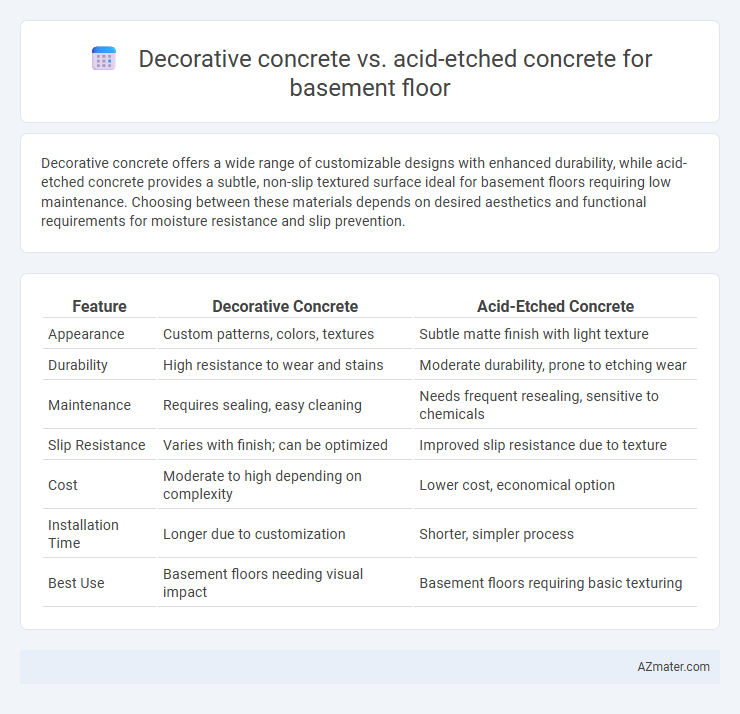Decorative concrete offers a wide range of customizable designs with enhanced durability, while acid-etched concrete provides a subtle, non-slip textured surface ideal for basement floors requiring low maintenance. Choosing between these materials depends on desired aesthetics and functional requirements for moisture resistance and slip prevention.
Table of Comparison
| Feature | Decorative Concrete | Acid-Etched Concrete |
|---|---|---|
| Appearance | Custom patterns, colors, textures | Subtle matte finish with light texture |
| Durability | High resistance to wear and stains | Moderate durability, prone to etching wear |
| Maintenance | Requires sealing, easy cleaning | Needs frequent resealing, sensitive to chemicals |
| Slip Resistance | Varies with finish; can be optimized | Improved slip resistance due to texture |
| Cost | Moderate to high depending on complexity | Lower cost, economical option |
| Installation Time | Longer due to customization | Shorter, simpler process |
| Best Use | Basement floors needing visual impact | Basement floors requiring basic texturing |
Introduction to Basement Flooring Options
Decorative concrete offers versatile design choices such as stamped patterns, stains, and dyes, creating an aesthetically pleasing basement floor with enhanced durability and easy maintenance. Acid-etched concrete provides a subtle, textured finish by chemically altering the surface, resulting in a slip-resistant and visually unique basement flooring solution. Both options improve basement functionality while adding value, but decorative concrete delivers more customization compared to the minimalist appeal of acid-etched surfaces.
What is Decorative Concrete?
Decorative concrete is a versatile flooring option that enhances basement floors through techniques such as stamping, staining, and polishing to create visually appealing and customized surfaces. It offers durability, low maintenance, and a wide range of design possibilities, including resembling natural stone, brick, or intricate patterns. Acid-etched concrete, a specific decorative method, uses acid solutions to create subtle textures and unique finishes, but decorative concrete encompasses a broader array of styles and treatments for aesthetic basement flooring enhancements.
What is Acid-Etched Concrete?
Acid-etched concrete is a decorative concrete technique where a solution of mild acids carefully dissolves the surface layer, creating subtle texture and a matte finish ideal for basement floors. This process enhances slip resistance and reveals natural aggregate patterns without altering the concrete's structural integrity. Compared to other decorative methods, acid etching offers an affordable, low-maintenance option suitable for high-moisture basement environments.
Aesthetic Differences: Decorative vs Acid-Etched Concrete
Decorative concrete for basement floors offers a wide range of design possibilities, including stamped patterns, stains, and overlays, resulting in intricate textures and vibrant colors that enhance visual appeal. Acid-etched concrete creates subtle, matte finishes by chemically reacting with the surface, producing a natural, slightly rough texture with muted tones ideal for understated elegance. The aesthetic difference lies in decorative concrete's versatility and bold expression versus acid-etched concrete's subdued, organic character that complements minimalist or rustic interiors.
Durability and Longevity Comparison
Decorative concrete offers enhanced durability for basement floors with its versatile surface treatments, resisting wear, stains, and moisture better than acid-etched concrete, which can be more susceptible to damage due to its porous texture. Acid-etched concrete provides moderate longevity but requires regular sealing to prevent degradation and maintain appearance, while decorative concrete systems such as overlays and stains deliver longer-lasting protection and aesthetic appeal. For basement environments, decorative concrete ensures a more robust and enduring flooring solution compared to the relatively fragile acid-etched alternative.
Cost Analysis: Which Option is More Affordable?
Decorative concrete typically costs between $3 to $12 per square foot, influenced by factors such as stamping, staining, and finishing techniques, making it a versatile yet affordable option for basement floors. Acid-etched concrete generally ranges from $2 to $5 per square foot, offering lower upfront costs but with potential for higher maintenance expenses due to its porous surface prone to staining and wear. Considering both initial installation and long-term upkeep, acid-etched concrete may be more budget-friendly initially, while decorative concrete provides greater durability and design value, potentially reducing replacement costs over time.
Installation Process Overview
Decorative concrete for basement floors involves mixing pigments, stamping, or stenciling patterns before curing to create custom visual effects, requiring skilled labor and precise timing during the finishing stage. Acid-etched concrete uses acidic solutions to chemically react with the surface, producing a textured, matte finish that is typically quicker to apply but demands careful handling of hazardous materials. Both methods need proper surface preparation and sealing post-installation to ensure durability and resistance to moisture commonly found in basement environments.
Maintenance Requirements for Both Finishes
Decorative concrete for basement floors typically requires regular sealing to maintain its appearance and prevent staining, with occasional cleaning using pH-neutral cleaners to avoid surface damage. Acid-etched concrete demands more frequent resealing due to its porous surface, and harsh chemicals or abrasive cleaning methods can degrade the finish over time. Both finishes benefit from prompt spill cleanup and dust-free environments to extend longevity and preserve aesthetic quality.
Safety and Slip Resistance in Basement Use
Decorative concrete offers enhanced slip resistance for basement floors through textured finishes and non-slip sealers, making it safer in wet or damp conditions. Acid-etched concrete increases surface grip by creating micro-roughness but may wear down over time, potentially reducing its slip resistance. Selecting decorative concrete for basements typically provides longer-lasting safety benefits and better protection against slipping hazards.
Which Concrete Finish is Best for Your Basement?
Decorative concrete offers a wide range of customizable patterns, colors, and textures, creating a durable and visually appealing basement floor that can mimic natural stone or tile. Acid-etched concrete provides a subtle, matte finish with enhanced slip resistance, making it ideal for basements prone to moisture while requiring lower maintenance. Choosing the best concrete finish depends on your style preferences, moisture levels, and desired durability for your basement space.

Infographic: Decorative concrete vs Acid-etched concrete for Basement floor
 azmater.com
azmater.com